A Series of Unfortunate Events
It seems that Anthony and I do one big ski day each spring: the Snoqualmie Haute Route last spring, and the Isolation Traverse the year before. For many years, he has been pitching a different grand idea: ski Little Tahoma and Big Tahoma (Rainier) in a day. I had never given the idea serious consideration, but decided to give it some thought with a fat snowpack and a sunny weekend at last. After walking up the Emmons Glacier seven years ago, I had never actually returned to ski the mountain, so I was game for anything.
There are many ways to skin this cat. Little Tahoma is southeasterly and lower elevation so it would need to be skied first. From there, you could either drop to the Ingraham Glacier and climb the DC or figure out how to get onto the Emmons Glacier. We felt like climbing up the DC or Ingraham Direct in the heat of the day would be unwise, so the Emmons seemed like the safest bet, although it was more gain. I chatted with Jason “Humdog Millionaire” Hummel (credit to Sam for the nickname) and he recommended starting at Summerland and approaching Little T that way. Timing would be a challenge. Hopefully we would get up and down the Emmons before it went into the shade and refroze.
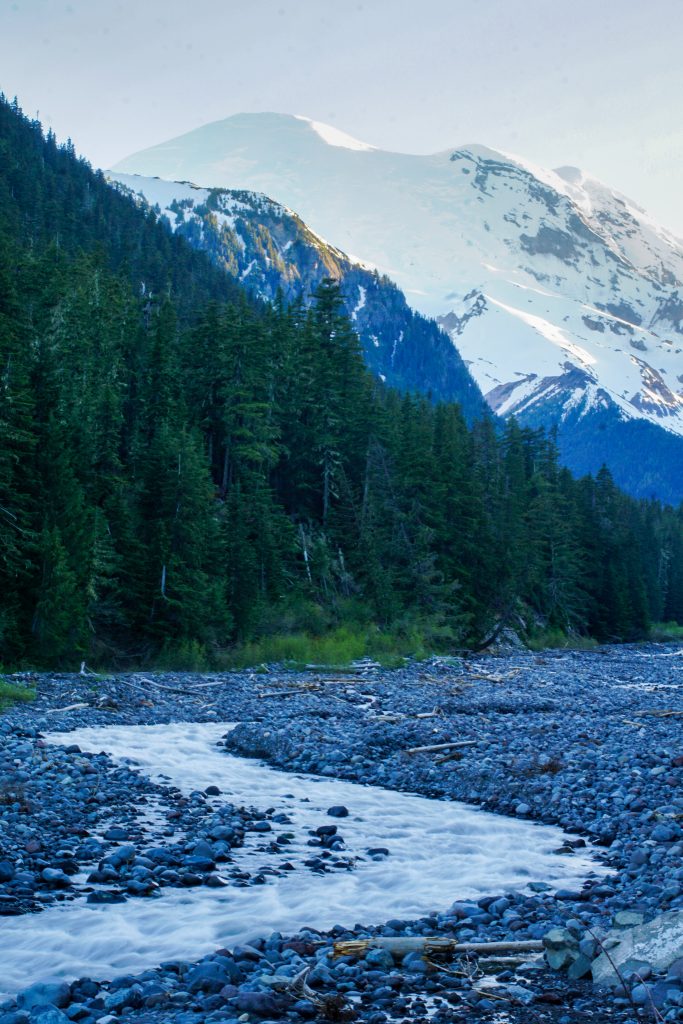
Will and Logan also volunteered to be victims so we all started from the Summerland trailhead around 1:45 am on Saturday. The trail was mostly snow free to the river crossing at 3 miles. Like all bridges in Mount Rainier National Park, this one had washed out, but Sam gave us the beta that there was a log crossing just upstream. After crossing the river, we were skinning nice and firm snow up towards Meany Crest.

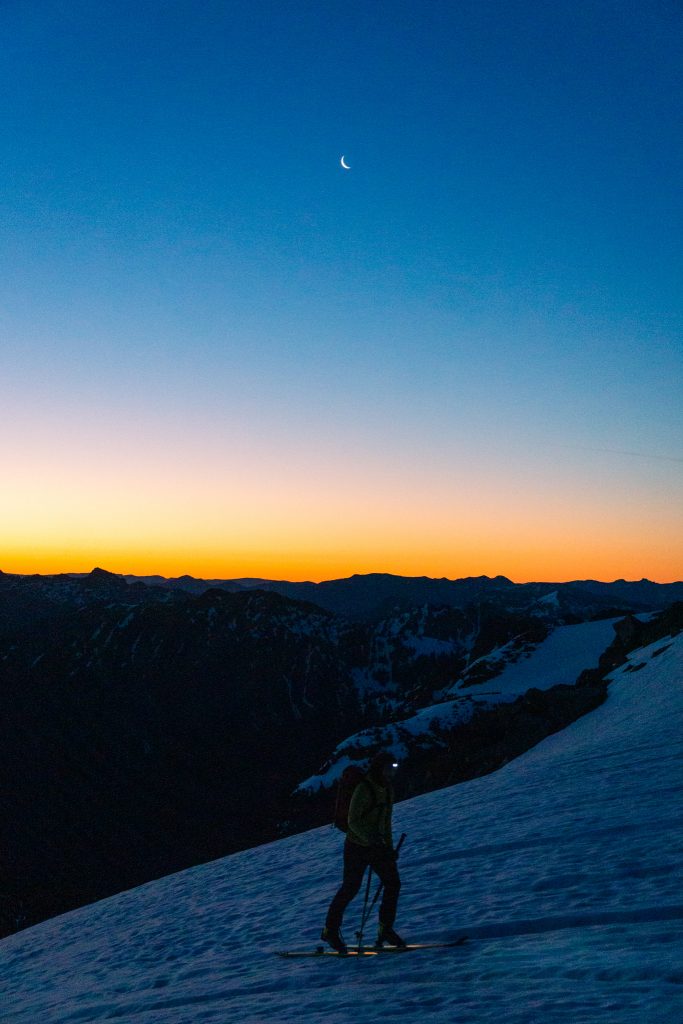
We crested Meany Crest just as the horizon climaxed in an orange glow. I turned back and caught the silhouettes of Will and Logan skinning. I love moments like these, unexpected but so perfect.

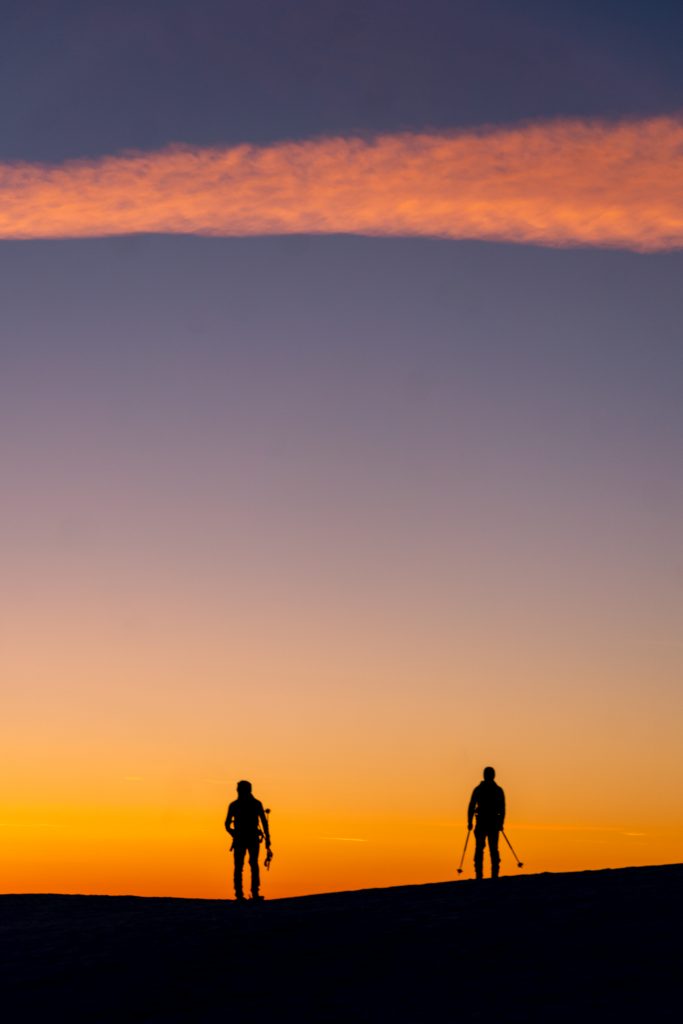
We were onto the Fryingpan Glacier when the sun finally peeked over the horizon. Travel was firm and fast.

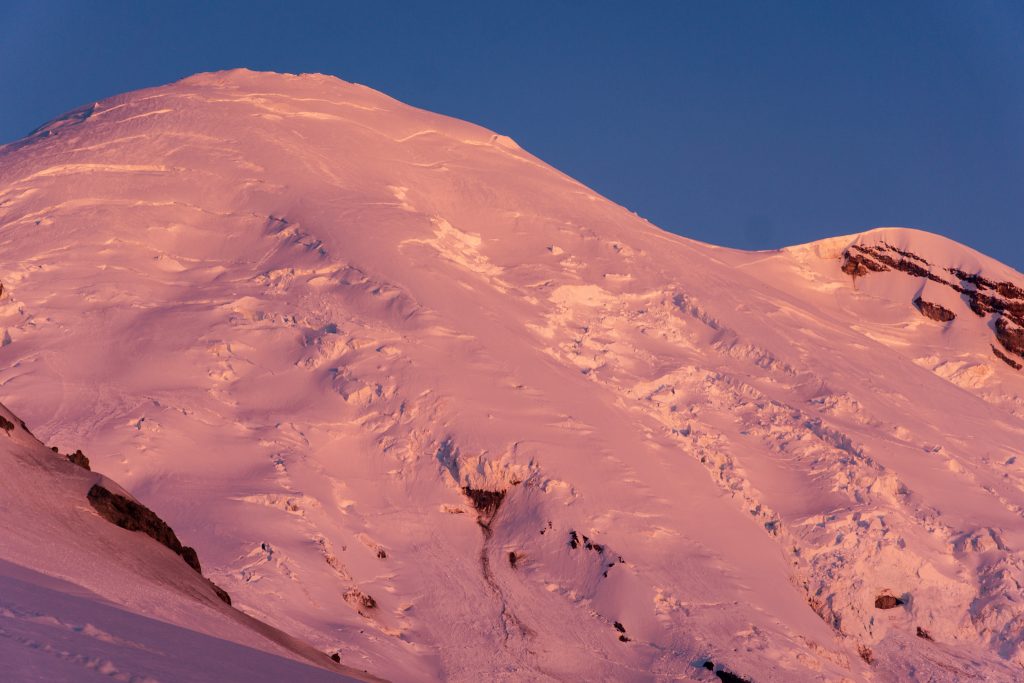

I’m not sure why I did not expect it, but the views were really good from this side of Little T. We were high enough to see all the way to Baker, Glacier Peak, and Stuart. The Cascades revealed themselves in those beautiful layers that are oh-so-Cascadian.
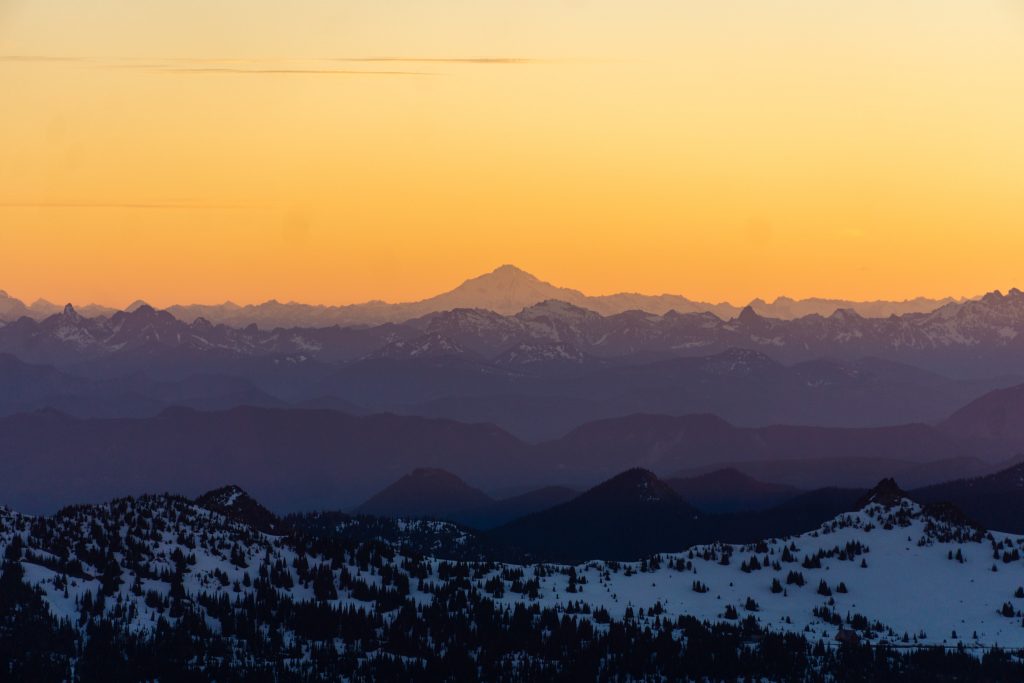
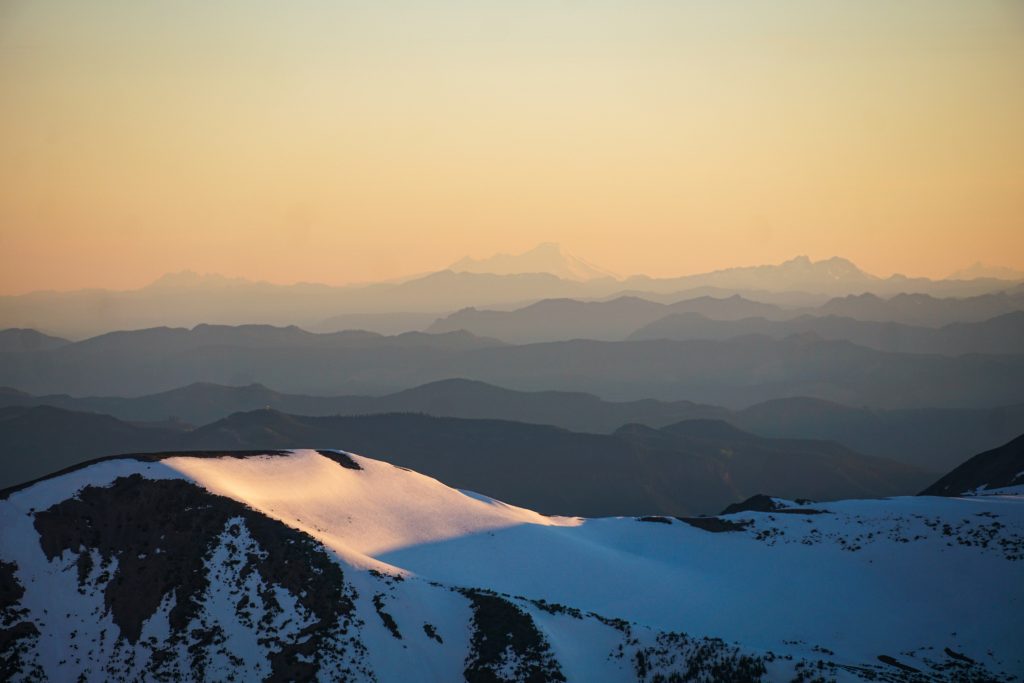
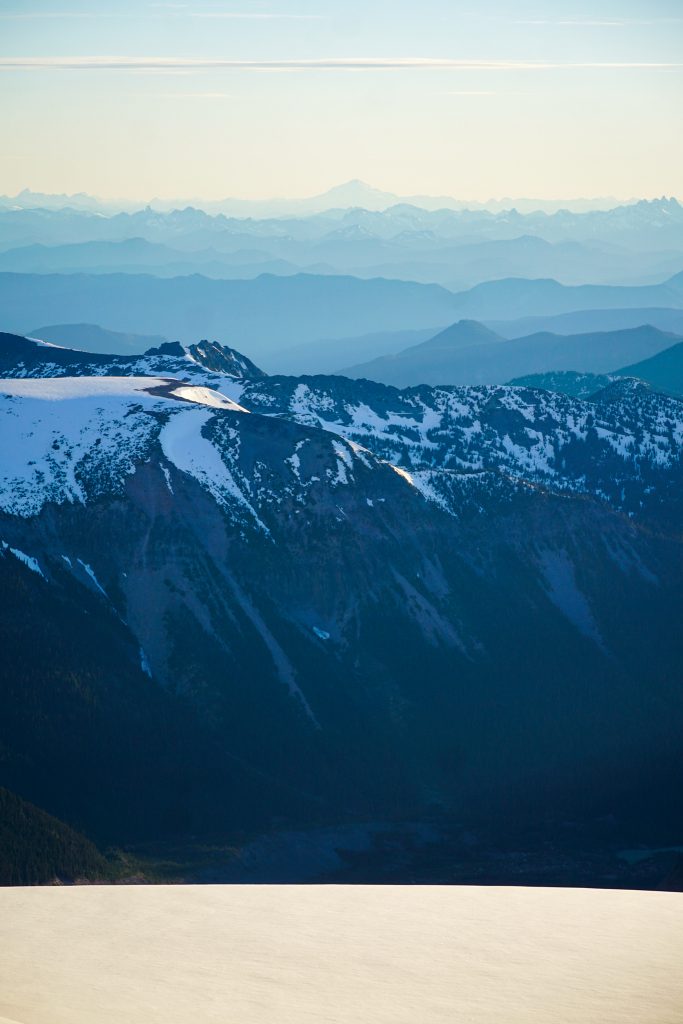
We could see from Jefferson to Baker, a distance of nearly 300 miles.
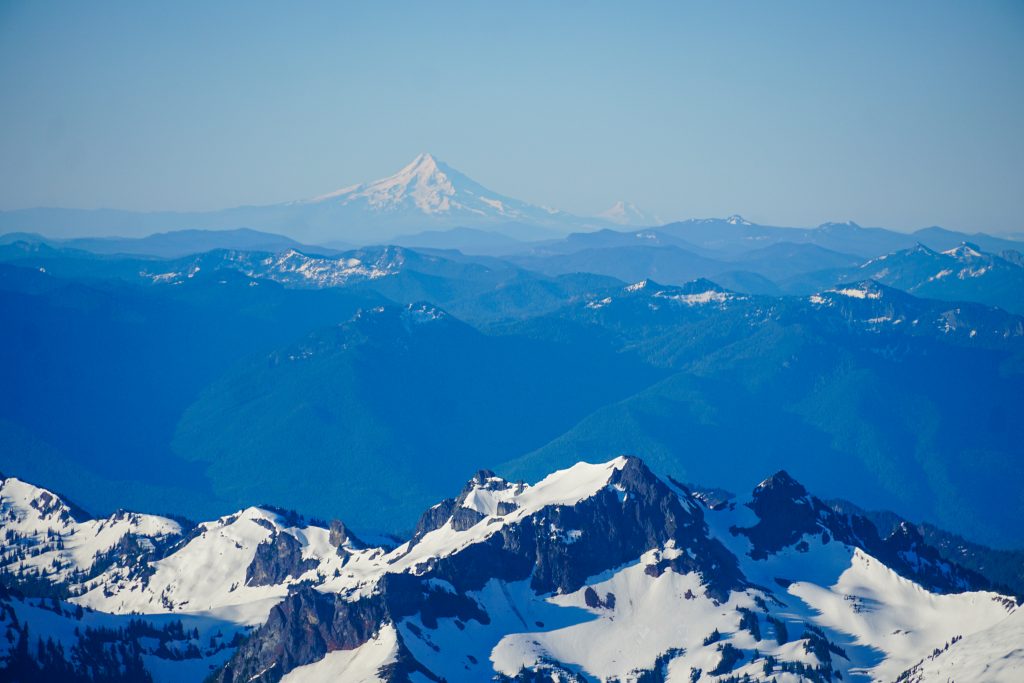
At the saddle between the Fryingpan and Whitman Glaciers, there was a cold breeze. This long glacial approach reminded me a lot of skiing the Sulphide Glacier on Shuksan.

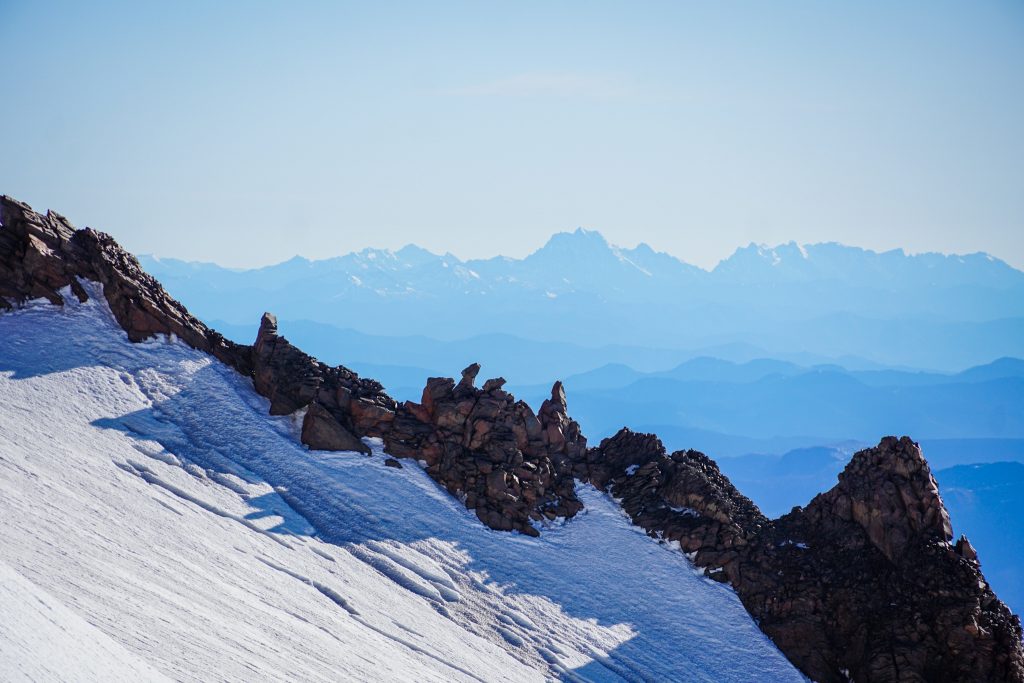
The final climb up Little T is mostly moderate, with one steeper section of maybe close to 40 degrees at the top. At 10800 ft, we wrapped around to the snowfield on the left, which took us to within 50 feet of the true summit.
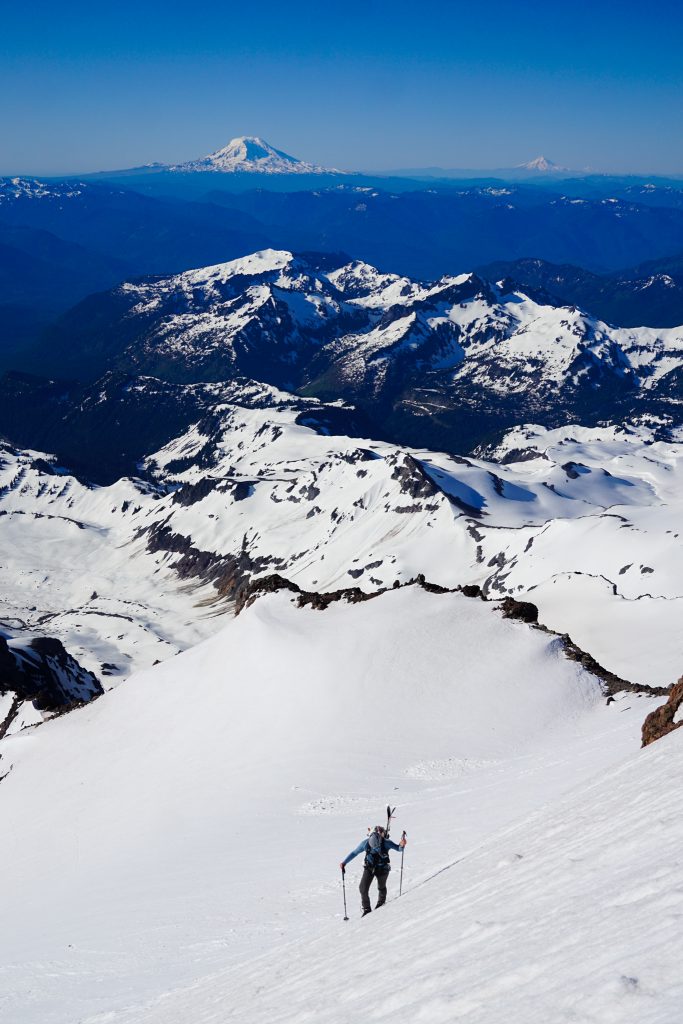
The summit scramble was rather short, with just a little bit of exposed class 4 on decent rock. The summit views from Little T are excellent – wide reaching, not too high as to be aloof, and with the Big T looming massive.


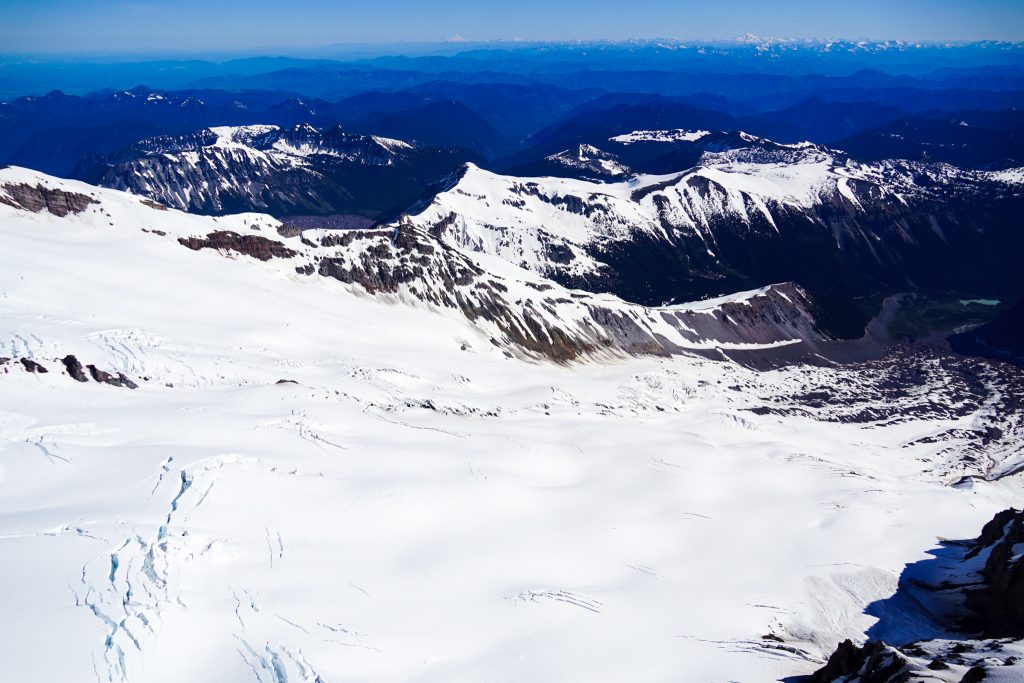
Up until this point, everything was going perfectly. We cruised to the summit in under 7 hours and were prepared to harvest the 9 am corn. But the water sources Sam had found a few days earlier were still frozen, so we had to search elsewhere. Water was imperative for us to continue. We hiked around some cliffbands, trying to find running water of a substantial enough volume. In one moaty section, Logan’s pack rolled off a platform and the contents spilled out onto the snowfield beneath us. He had to ski down slowly, collection the pieces of gear as he went. And still, we had no real water.
Anthony skied down more to the east through a col that would take us directly towards K Spire and our entrance to the Emmons. This would have saved us time, but unfortunately we had to go lower down the Whitman to retrieve Logan’s gear. I did end up finding a slow water source here, enough to refill my bottles. Even with all the shenanigans, we were able to enjoy some great corn down the Whitman Glacier. Overall, I was impressed with Little Tahoma as a standalone tour.

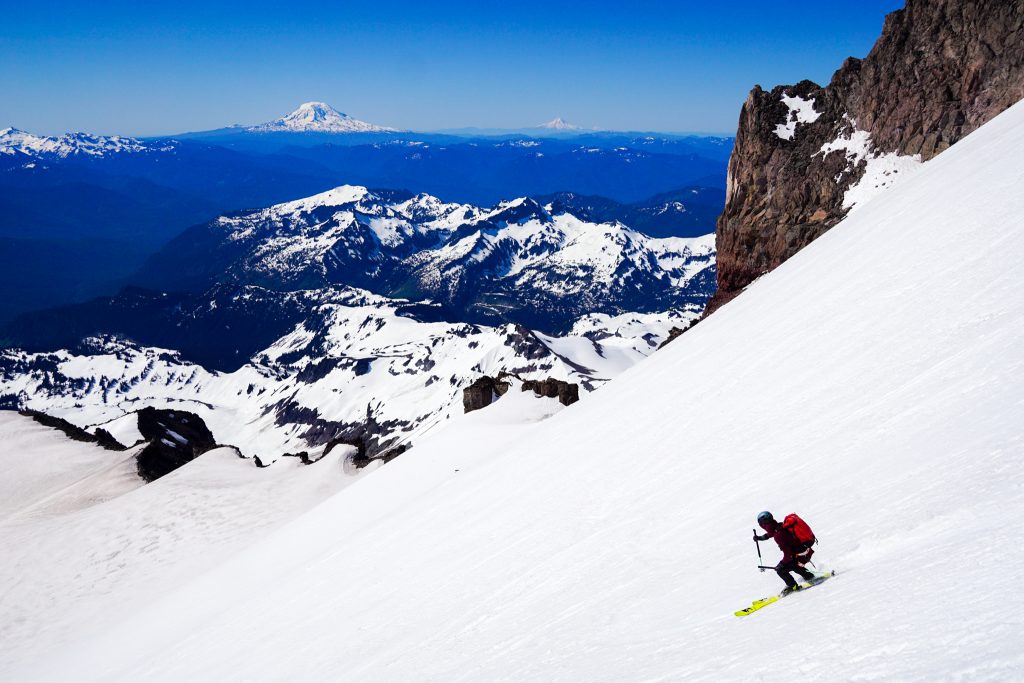
Back at the Whitman / Fryingpan col, we regrouped and traversed the Fryingpan glacier towards the notch just left of K Spire. This required some flat shuffling. As I said earlier, there is a higher col that can drop you down directly here but it was not an option after Logan’s pack decided to go skiing for itself.
This gully down to the Emmons Glacier was a bit of a mystery. From internet pictures, it seemed to stay snow until relatively late season, but I had never heard of anyone using it. When we arrived, we were disappointed to find it mostly stripped of a snow. We looked up and saw a giant crown on the east face of Little Tahoma. The avy debris had apparently triggered a deep slab in this gully and a glide avalanche had run to bare ground. This spring has seen an abundance of giant avalanches on Rainier and there are ten foot tall crowns seemingly everywhere.

Both Logan and Will were feeling a bit tired at this point and knew they would not be able to complete the entire climb up Big T. We talked about all crossing the Emmons together and then parting ways at Camp Schurman but there really seemed to be no point of doing that for Will and Logan. So we said goodbye to our friends and they got a bonus corn run off Whitman Crest on the way back! It turned out they would ski far more corn that we would…
The descent down to the Emmons was expectedly loose, but manageable. Steel crampons were great in the mix of ice, choss, and frozen mud. But it was a bit tedious, and having planned to ski this slope, we were just falling even further behind. It was nearly 11 am when we finally got down to the Emmons.
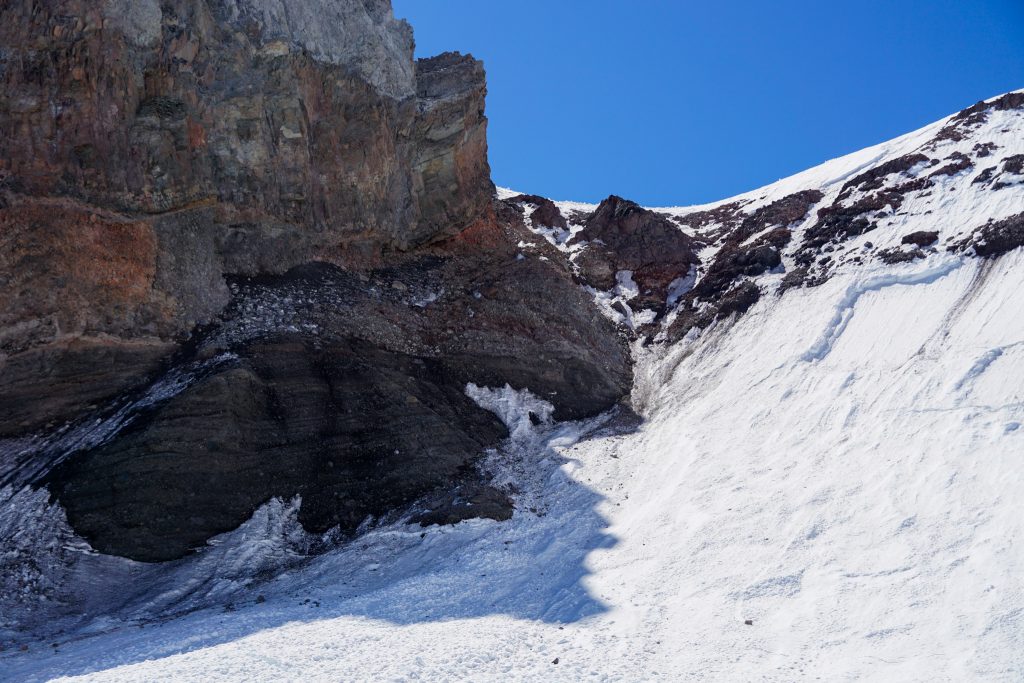
From the top of Little T, we had seen that we actually wanted to descend slightly to cross the Emmons. So we roped up and skinned across the giant glacier. The crossing was quite easy and crevasse free, although we did have to descend down to 7900 ft to make the crossing that easy. From there, we started to slowly grind up the Emmons towards Camp Schurman and the standard Emmons route. We had 6500 feet to climb in less than 6 hours if we wanted to top out by 5 PM. It seemed doable. I felt tired, but prepared myself mentally for a long slog.
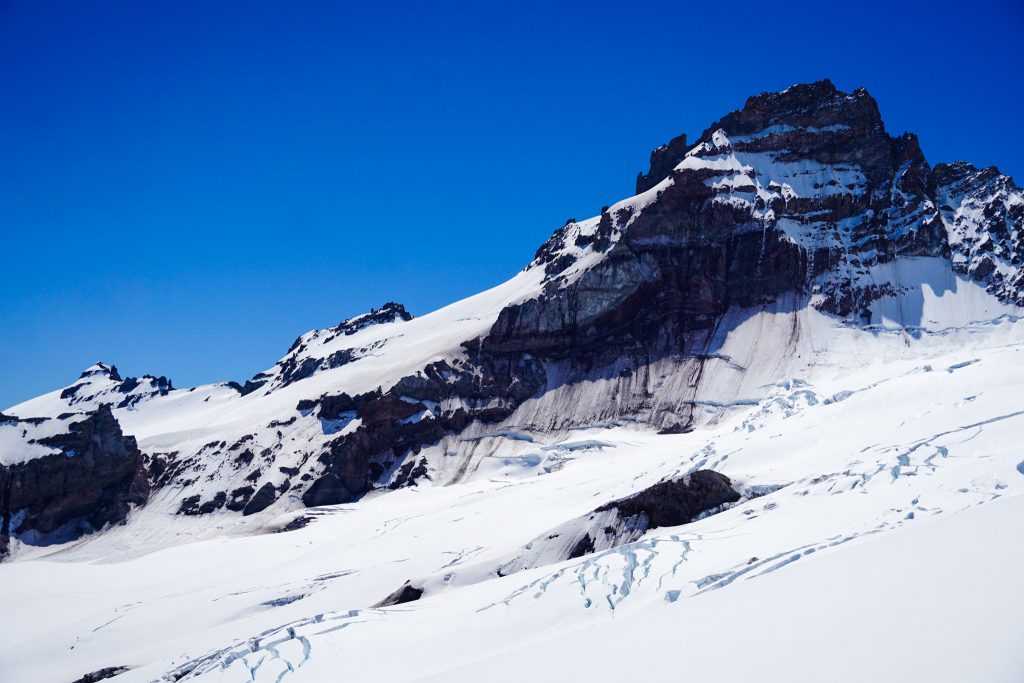
Initially, we were moving well, gaining about 1500 ft per hour. The snow was a nice firmness for easy skinning. Upon reaching Emmons Flats, we could tell the route had changed vastly since the last ranger report two weeks ago. Multiple crevasses had opened up and the route traversed much further right.
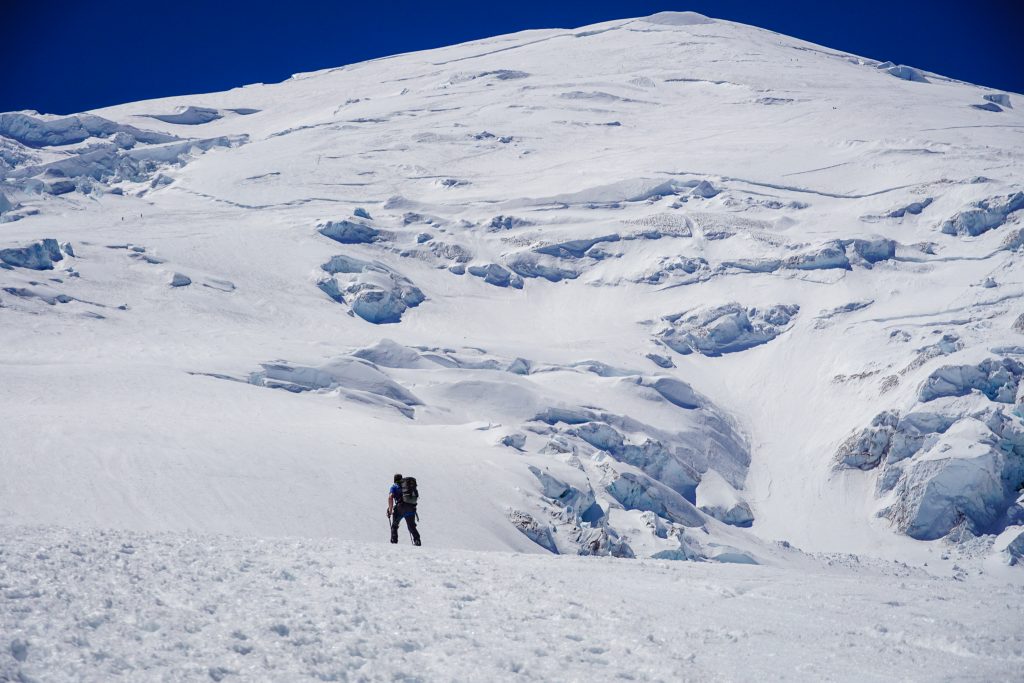
As we entered the first crevassed area around 11k (note there were a few flags marking key crossings in place), we watched some skiers come down above us. Anthony warned to them that there was a crevasse beneath them and one skier proceeded to yard sale over the crevasse and slide down the snow slope beneath head first. He seemed to almost be laughing, but Anthony and I were horrified, as he seemed to have no clue how to stop himself. I shouted “Get your skis downhill!” which he did and then was able to stop. If the snow was not soft, we might have witnessed a fatality. I have never seen someone so non-chalant about skiing on a crevassed glacier.
As we got higher up, we kept talking to parties walking down with their skis, explaining that the upper mountain above 12,500 ft was bulletproof ice. Everyone seemed surprised. Even the rangers at Schurman had apparently predicted “corn top to bottom”. It was 85 degrees in Seattle, but even that was not enough to soften this northerly aspect on Rainier. How hot does it have to be to get corn on the Emmons?
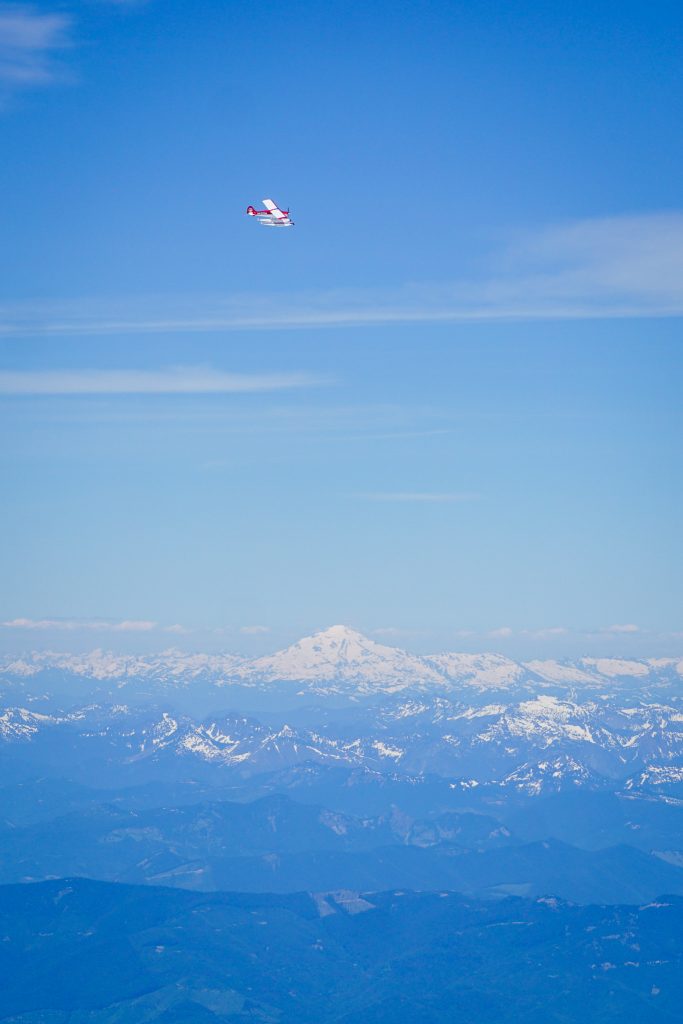

It got cold and windy and the snow surface changed drastically around 12.5k, just as others told us it would. Up here, it was still winter, with shiny white ice that barely held a ski edge and windblown sastrugi in places. We had heard that there were multiple close calls earlier in the day with skier falls on the ice. Why is the upper mountain so bad this year? I do not have a lot of experience with Rainier, but it seems that between the incessant spring storms, rain, wind, snow, and cold temperatures we have not had enough warmups to transition the snowpack to more of a spring texture. I think we need that week of sunny, warm weather in May to set things up on the volcanoes. Oh, yeah, that never happened this year. Perhaps it is closer to April up there than late June.

Anthony was starting to get low on rations and asked some others descending for supplies. A man named River gave us candy and a solo skimo dude Ben, who had just climbed Liberty Ridge, gave us caffeine pills. But it did not stop the wheels from coming off the bus, at least for me.
The last thousand feet to the summit went on for what felt like hours. The mountains seemed to never end. Giant features of ice above us appeared no closer every time I looked up. I staggered a few steps, rested on my poles, and continued. No muscles were cramping, no headaches, just complete fatigue. It was wild. But we were closing in on 14,000 ft of gain, up at an elevation of 14,000 ft. This was probably the most tired I have ever been without bonking. Getting to the summit was really, really hard. Anthony was struggling too. We knew this would be hard, but we did not expect it to be that hard.
We reached the summit, Columbia Crest, at 5:30 PM. We were a bit behind where we wanted to be, but we expected the snow to still be manageable on the way down. We had heard from others that someone actually skied down the day before at 6 PM and hit the softest conditions of the day, so we were hopeful to be on that schedule! Supposedly the Emmons had refrozen around 7 PM the day before, and it was even hotter on this day.
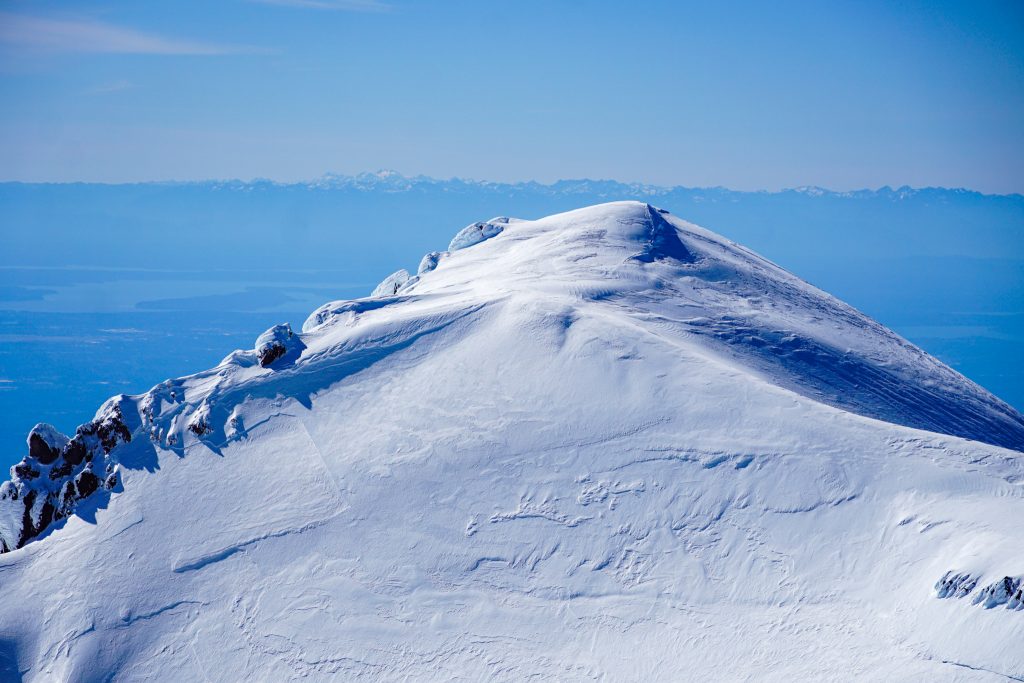
It had been seven years since I stood atop the summit of Rainier and I had forgotten truly how lackluster the views are up here. It is so much taller than everything else that there is no context. The flat summit plateau spreads in all directions, cutting off the horizon. It is definitely the most overrated summit view in the state. Now that it is logged, even West Tiger 3 has a better view.
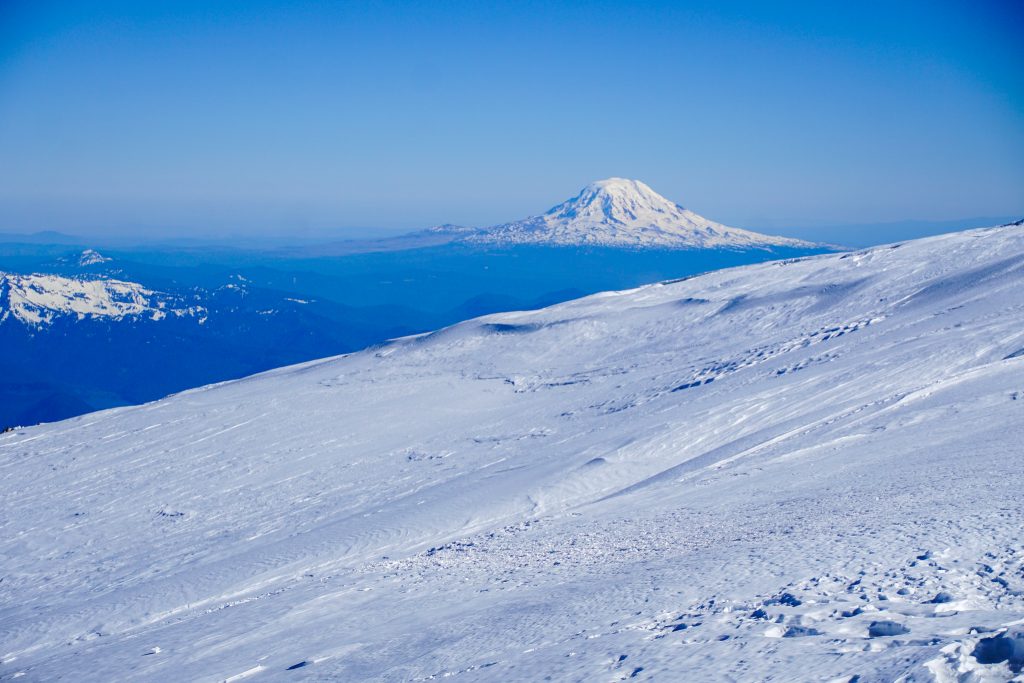
We spent all of a few minutes up top before beginning our descent. We hiked down to about 13,600 ft, the bergschrund crossing, since the top was not skiable sastrugi. Then we clicked into our skis and started making our way down. Since this upper mountain had never softened, it also had not refrozen. It was icy and firm, but definitely manageable and we made decent time hop turning down the slope carefully.
Between about 12.4k and 11.2k, conditions went from manageable to absolutely heinous. Here the snow had previously softened and now refroze, even though sunlight was still on sections of it. Anthony and I have both skied our fair share of refrozen snow and knew how to deal with it. The slope angle was only low 30s. But this slope was different – it had been hammered by climbers and skiers all day in soft snow. It was real resort chunder: big balls of ice, bumps from other skiers side slipping, almost legit moguls. We both immediately gave up on any real skiing and side slipped our way down, skis bouncing on the balls of ice and our quads burning. I only turned when I needed to change my side slip direction and give one leg a break.
Anthony was really struggling on his wider 97 underfoot skis. Progress was really, really slow. Eventually, even he had enough and declared he would just boot down. This is a man who has skied an 8000m peak without supplemental oxygen. And he decided to boot down the Emmons. That is how bad conditions were.
Below 11.2k, the corridor widened and I was finally able to escape the narrow chundery path. Here, the snow had refrozen into a supportable crust and I could actually link turns. It eventually gave way to true breakable crust down to Emmons Flats, where I took a big break to rest and process what had just been quite possibly the worst ski descent of my life.
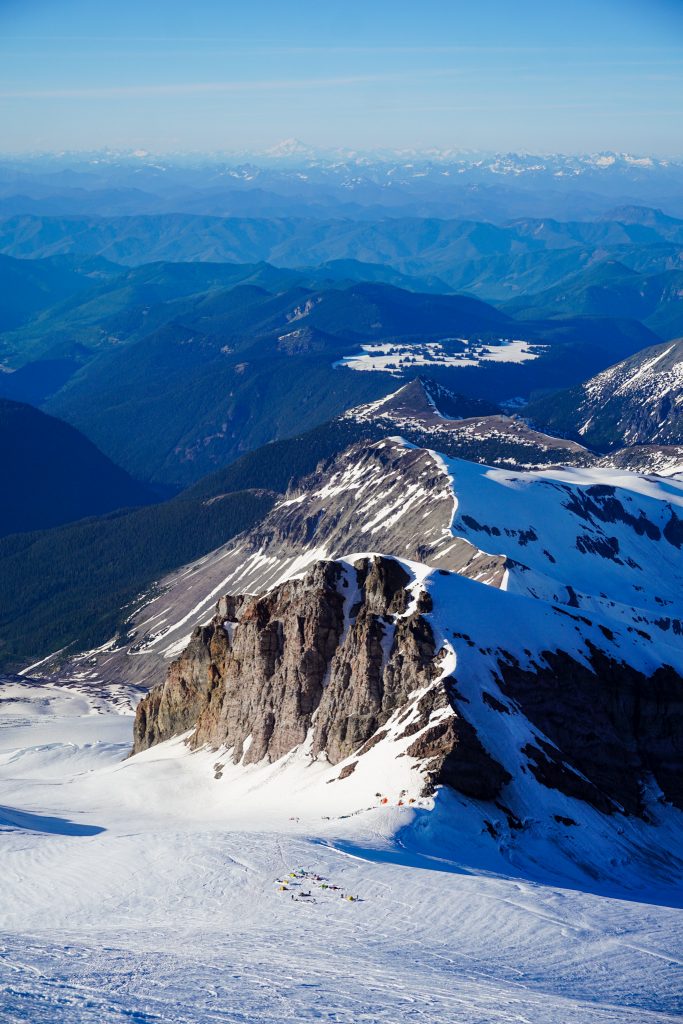
It was nearly 7:30 PM when Anthony reached me at Emmons Flats. There were no tears, no emotions, just shock. I have never seen him like that before, with a look of emptiness in his eyes and his soul. He said it was most definitely the worst ski run of his life. He never knew snow could be that bad.
The Interglacier was some of the deepest schmoo I have ever experienced. My GPS track in this section looked like an uptrack because I traced back and forth across the slope, trying to minimize the number of turns I had to make and save my ACLs. As we got towards the valley bottom, the only fresh tracks were on the skier’s right side of the river. I knew that eventually the trail was on the left side of the river, but we figured there must be some reason people went on the right side, so we kept following the tracks down. Soon enough, we were stuck on the right side, tracks disappearing, with a torrential river between us, a washed out bridge, and no crossing in sight. Could it keep getting worse?
We saw skiers on the other (correct side) of the river and tried to speak with them, but it was impossible to talk over the raging waters. They pointed downstream, so we figured that meant there was a crossing further downstream. We continued to ski down, but found nothing and eventually the snow ran out into a steep riverbank. We were really hosed now.
We were left with either skinning back upstream a mile or more to the last snow bridge or taking a wet log crossing that might work. At this point, we did not care about wet feet, so we went with the log crossing. It involved an interesting shuttle where we had to toss both backpacks, skis, and poles across the stream between us. My heavy pack full of avalanche gear, glacier gear, camera gear, and approach shoes barely made it across. As I scooted across the log, I tore a giant hole in my favorite ski pants. RIP.

After a little more trail skiing, I switched back to trail runners for good. Anthony barged ahead in his ski boots. When I finally caught up to him, he was just standing in the dark with no headlamp. He said he was hallucinating and decided he just needed to wait for me. I guess that is what happens when you only drink 1.5 liters of water over 20 hours of activity.
We spent about 10 minutes getting lost in the White River Campground trying to find the parking lot, but finally reached my car at 10 PM. We had been on the move for just over 20 hours, far longer than the 16 hours we had predicted. A series of unfortunate events, one after another. But it was all over now, and Taco Bell in Enumclaw was open until 1 AM, so it was all good.
So what is the verdict on Little Tahoma plus Big Tahoma in a day? When Anthony first pitched it, I thought he was crazy. There was a brief period where I thought it sort of made sense. Now I have confirmed it is indeed crazy. Unless you are a speedy skimo fiend, I do not see a way to time both descents well. It simply takes too long between the descent of Little T and Big T. Yeah, it is possible, and we got it done despite our setbacks, but it definitely is not a “good” idea and I would not do it again unless I got substantially faster.
A common cliche in mainstream sports is that football is a “game of inches”. You could say that ski mountaineering is a “game of minutes”. Throughout the day, we lost minutes here and there: trying to find water, Logan’s pack exploding, booting down the gully near K Spire, having to drop lower on the Emmons, in the icy conditions on the upper mountain. In the end, we were some amount of minutes too late on the descent. So many things went wrong and so many predictions were incorrect. I do not think anyone, including the rangers, expected those conditions on the upper mountain. Everyone was concerned about heat, but cold and wind actually were the bigger problems. Rainier is a big mountain, with unpredictable conditions. It demands respect.
When we push the envelope of possibility, we tiptoe a fine line. We hedge our bets, make educated guesses, but ultimately relinquish some amount of control. A big day like this has so many moving parts and so many things that can go slightly wrong. When you go big, sometimes you succeed and it is the best feeling in the world, and other times you get smacked down. It is all part of the game. I am used to getting my way in the mountains, but I think it is healthy every once in a while to fail, be humbled, and reminded that we have limits and still so much to learn about the mountains. On this day, we definitely overestimated our abilities and underestimated the mountain. It was all solidly still Type 1.5 Fun until that terrible section of chunder in the middle of the Emmons. I do not think we would have gone all the way up if we had known it would be that bad on the way down. It never felt overly sketchy, but it was definitely beyond the point of enjoyment, and I do not really like suffering, as much as it may seem so. Even though it did not work out as we had hoped, I am still proud of our physical and mental stamina to tough it out. And most importantly, I am proud of Anthony for knowing his limits, swallowing his pride, and taking the safe way down. That is discipline, and it is discipline that gets us through the hardest and most stressful moments in life.
And with that epic adventure also comes the end of my ski season. I went months without skiing powder mid winter and skied tens of thousands of feet of breakable crust on skinny skis this spring. Good turns were few and far between. As I talked about last month, this season mentally defeated me. But at the end of this adventure, Anthony and I were the ones smiling and laughing. We had been beaten so badly that our resilience alone meant that we were the ultimate victors. If we can come out the other side and still laugh about it, then we can do most anything. We were tested and our spirits survived. I will glean toughness from this experience that will stay with me. For once this season, I finally felt like I won the battle, not of good skiing or epic sends, but of the mind. And that is what matters most.
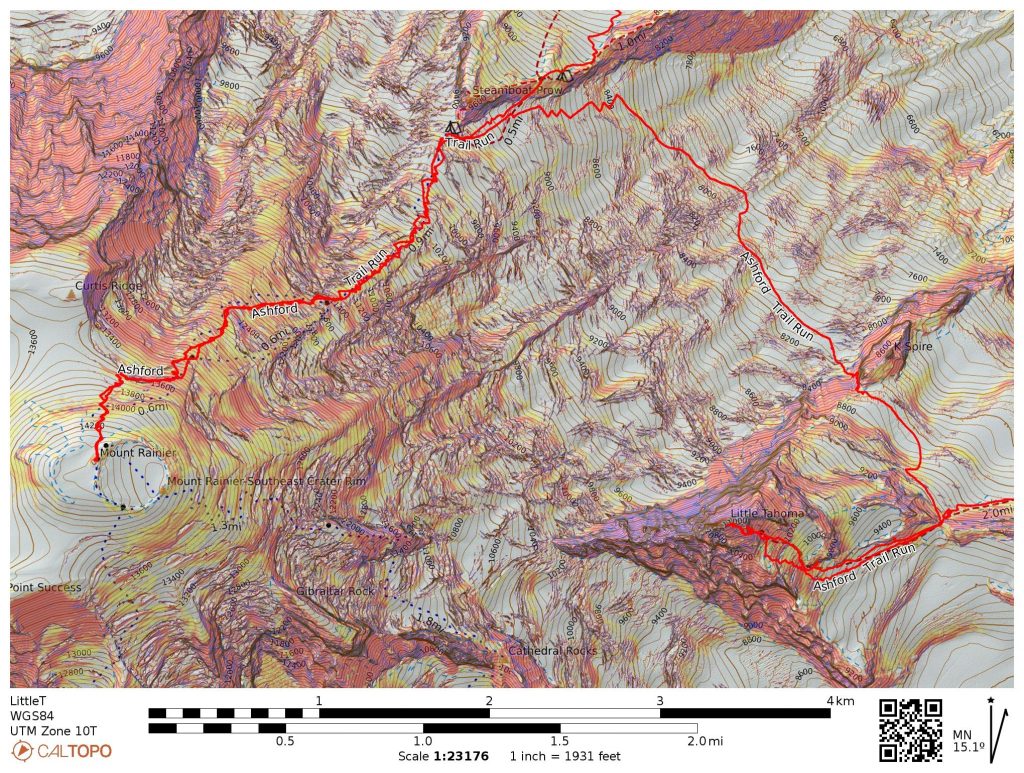
Notes:
- We measured about 26 miles and 14,500 ft of gain. We took 6.5 hours to the top of Little T, nearly 16 hours to the top of Big T, and 20 hours total.
- Little T is a very fun tour by itself. The glaciers are very filled in, the descents are long and moderate, and the views are excellent.
- We had to descend to about 7900-7800 ft to easily cross the Emmons. Crossing higher looked pretty crevassed. But this crossing was quite easy.
- The upper mountain above 12.5k was very icy with sastrugi.
- The Emmons had quite a few cracks open between 11k and 12.5k. Up high, the direct finish was viable, but we heard it was icy, so we traversed beneath the bergschrund to the saddle between Liberty Cap and Columbia Crest. Overall, the Emmons felt way more full on than I expected. It is definitely a step up from the Coleman Deming or Squak/Easton on Baker.
- Be sure to stay on the north side of the White River after descending the Interglacier.
- I was super glad to have brought steel crampons. Aluminum crampons would not have cut it on the frozen mud, rocks, and ice.
- Now that I have skied Little T and Big T in a day, I think I am finally ready for the ultimate goal: skiing Little Si and Big Si in one day!

Just got back from a trip up (most of) the Emmons, and I think “A Series of Unfortunate Events” describes our trip pretty well too. We skied from 11k, and it seems like the snow managed to go from ice to mashed potatoes immediately, with no decent snow in the middle…
The real question though… how was the Enumclaw Taco Bell open on Saturday??? We tried going Tuesday and it was closed at 9pm 🙁
Guess TBell stays open late on the weekends! Big bummer after a rough trip…